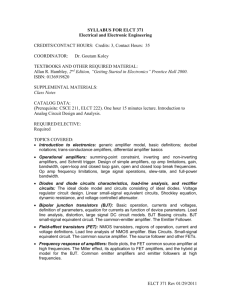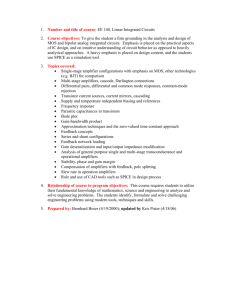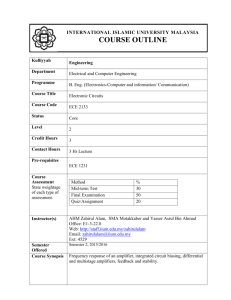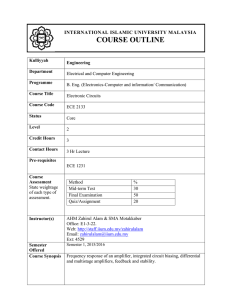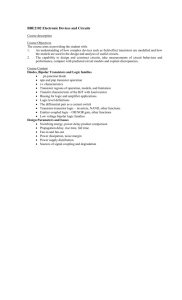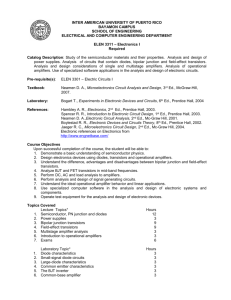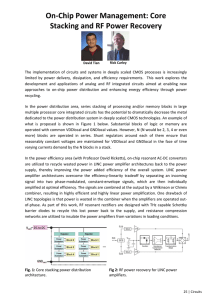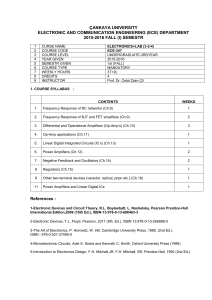Document 13339790
advertisement
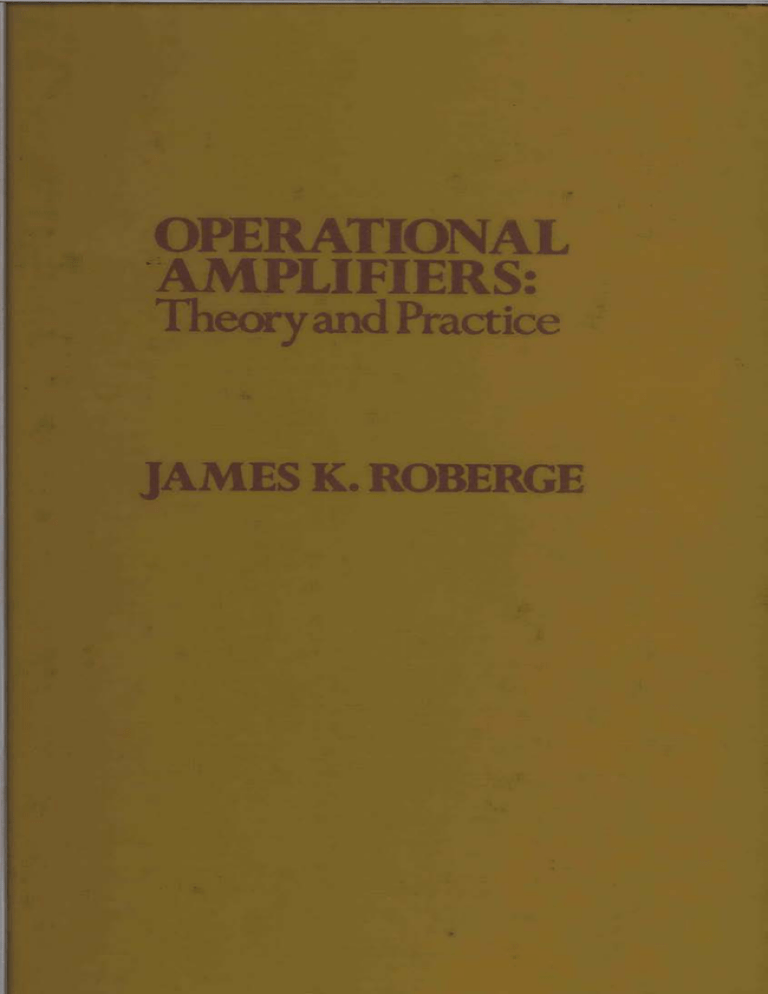
OPERATIONAL AMPLIFIERS: Theory and Practice OPERATIONAL AMPLIFIERS Theory and Practice JAMES K. ROBERGE Massachusetts Institute of Technology JOHN WILEY & SONS, Inc. New York - Chichester - Brisbane - Toronto - Singapore To Nancy PREFACE The operational amplifier is responsible for a dramatic and continuing revolution in our approach to analog system design. The availability of high performance, inexpensive devices influences the entire spectrum of circuits and systems, ranging from simple, mass-produced circuits to highly sophisticated equipment designed for complex data collection or processing operations. At one end of this spectrum, modern operational amplifiers have lowered cost and improved performance; at the other end, they allow us to design and implement systems that were previously too complex for consideration. An appreciation of the importance of this component, gained primarily through research rather than academic experience, prompted me in 1969 to start a course at M.I.T. focusing on the operational amplifier. Initially the course, structured as part of an elective sequence in active devices, concentrated on the circuit techniques needed to realize operational amplifiers and on the application of these versatile elements. As the course evolved, it became apparent that the operational amplifier had a value beyond that of a circuit component; it was also an excellent instructional vehicle. This device supplied a reason for studying a collection of analytic and design techniques that were necessary for a thorough understanding of operational amplifiers and were also important to the general area of active-circuit design. For example, if we study direct-coupled amplifiers in detail, with proper attention given to transistor-parameter variation with temperature, to loading, and to passive-component peculiarities, we can improve our approach to the design of a large class of circuits dependent on these concepts and also better appreciate operational amplifiers. Similarly, the use of an active load to increase dramatically the voltage gain of a stage is a design technique that has widespread applicability. The vii viii Preface integrated-circuit fabrication and design methods responsible for the economical realization of modern operational amplifiers are the same as those used for other linear integrated circuits and also influence the design of many modern discrete-component circuits. Chapters 7 to 10 reflect the dual role of the operational-amplifier circuit. The presentation is in greater detail than necessary if our only objective is to understand how an operational amplifier functions. However, the depth of the presentation encourages the transfer of this information to other circuit-design problems. A course based on circuit-design techniques and some applications material was taught for two years. During this period, it became clear that in order to provide the background necessary for the optimum use of operational amplifiers in challenging applications, it was necessary to teach material on classical feedback concepts. These concepts explain the evolution of the topology used for modern amplifiers, suggest configurations that should be used to obtain specific closed-loop transfer functions, and indicate the way to improve the dynamics of operational-amplifier connections. The linear-system theory course that has become an important part of most engineering educational programs, while providing valuable background, usually does not develop the necessary facility with techniques for the analysis and synthesis of feedback systems. When courses are offered in feedback, they normally use servomechanisms for their examples. Although this material can be transferred to a circuits context, the initial assimilation of these ideas is simplified when instruction is specifically tailored to the intended field of application. Chapters 2 to 6 and Chapter 13 present the techniques necessary to model, analyze, and design electronic feedback systems. As with the circuitrelated material, the detail is greater than the minimum necessary for a background in the design of connections that use operational amplifiers. This detail is justifiable because I use the operational amplifier as a vehicle for presenting concepts valuable for the general area of electronic circuit and system design. The material included here has been used as the basis for two rather different versions of the M.I.T. course mentioned earlier. One of these concentrates on circuits and applications, using material from Chapters 7 to 10. Some application material is included in the examples in these chapters, and further applications from Chapters 11 and 12 are included as time permits. Some of the elementary feedback concepts necessary to appreciate modern operational-amplifier topologies are also discussed in this version. The second variation uses the feedback material in Chapters 2 to 6 and Chapter 13 as its central theme. A brief discussion of the topology used Preface ix for modern operational amplifiers, such as that presented in portions of Chapters 8 and 10, is included in this option. The applications introduced as examples of feedback connections are augmented with topics selected from Chapters 11 and 12. A laboratory has been included as an integral part of both options. In the circuits variation, students investigate specific circuits such as directcoupled amplifiers and high-gain stages, and conclude their laboratory experience by designing, building, and testing a simple operational amplifier. In the feedback version, connections of operational amplifiers are used to verify the behavior of linear and nonlinear feedback systems, to compare time-domain and frequency-domain performance indices, and to investigate stability. We have found it helpful to have ready access to some kind of computational facilities, particularly when teaching the feedback material. The programs made available to the students reduce the manual effort required to draw the various plots and to factor polynomials when exact singularity locations are important. Both versions of the course have been taught at least twice from notes essentially identical to the book. The student population consisted primarily of juniors and seniors, with occasional graduate students. The necessary background includes an appreciation of active-circuit concepts such as that provided in Electronic Principles by P. E. Gray and C. L. Searle (Wiley, New York, 1969), Chapters 1 to 14. An abbreviated circuits preparation is acceptable for the feedback version of the course. Although a detailed linear-systems background stressing formal operational calculus and related topics is not essential, familiarity with concepts such as polezero diagrams and elementary relationships between the time and the frequency domain is necessary. Some of the more advanced applications in Chapters 11 and 12 have been included in a graduate course in analog and analog/digital instrumentation. The success with this material suggests a third possible variation of the course that stresses applications, with feedback and circuit concepts added as necessary to clarify the applications. I have not yet had the opportunity to structure an entire course in this way. It is a pleasure to acknowledge several of the many individuals who contributed directly or indirectly to this book. High on the list are three teachers and colleagues, Dr. F. Williams Sarles, Jr., Professor Campbell L. Searle, and Professor Leonard A. Gould, who are largely responsible for my own understanding and appreciation of the presented material. Two students, Jeffrey T. Millman and Samuel H. Maslak, devoted substantial effort to reviewing and improving the book. x Preface Most of the original manuscript and its many revisions were typed and illustrated by Mrs. Janet Lague and Mrs. Rosalind Wood. Miss Susan Garland carefully proofread the final copy. James K. Roberge Cambridge, Massachusetts February, 1975 CONTENTS Page BACKGROUND AND OBJECTIVES 1.1 1.2 1.2.1 1.2.2 1.2.3 1.3 II Introduction The Closed-Loop Gain of an Operational Amplifier Closed-Loop Gain Calculation The Ideal Closed-Loop Gain Examples Overview Problems PROPERTIES AND MODELING OF FEEDBACK SYSTEMS 2.1 2.2 2.3 2.3.1 2.3.2 2.3.3 2.3.4 2.4 2.4.1 2.4.2 2.4.3 2.5 Introduction Symbology Advantages of Feedback Effect of Feedback on Changes in Open-Loop Gain Effect of Feedback on Nonlinearities Disturbances in Feedback Systems Summary Block Diagrams Forming the Block Diagram Block-Diagram Manipulations The Closed-Loop Gain Effects of Feedback on Input and Output Impedance Problems 1 1 2 3 6 10 13 15 21 21 22 23 24 26 30 31 32 32 38 43 46 54 xi xii Contents Page III LINEAR SYSTEM RESPONSE 63 3.1 3.2 3.2.1 3.2.2 3.2.3 3.3 3.3.1 3.3.2 3.4 3.5 63 67 67 69 74 76 76 78 81 3.6 3.6.1 3.6.2 IV STABILITY 4.1 4.2 4.2.1 4.2.2 4.3 4.3.1 4.3.2 4.3.3 4.3.4 4.3.5 4.4 4.4.1 4.4.2 4.4.3 V Objectives Laplace Transforms Definitions and Properties Transforms of Common Functions Examples of the Use of Transforms Transient Response Selection of Test Inputs Approximating Transient Responses Frequency Response Relationships Between Transient Response and Frequency Response Error Coefficients The Error Series Examples Problems The Stability Problem The Routh Criterion Evaluation of Stability Use as a Design Aid Root-Locus Techniques Forming the Diagram Examples Systems With Right-Half-Plane Loop-Transmission Singularities Location of Closed-Loop Zeros Root Contours Stability Based on Frequency Response The Nyquist Criterion Interpretation of Bode Plots Closed-Loop Performance in Terms of Loop-Transmission Parameters Problems COMPENSATION 5.1 5.2 Objectives Series Compensation 92 97 98 99 104 109 109 112 112 116 118 119 126 130 133 136 139 139 145 149 158 165 165 165 Contents xiii Page 5.2.1 5.2.2 5.2.3 5.2.4 5.2.5 5.2.6 5.3 VI VII Adjusting the D-C Gain Creating a Dominant Pole Lead and Lag Compensation Example Evaluation of the Effects of Compensation Related Considerations Feedback Compensation Problems 165 168 171 177 186 191 196 200 NONLINEAR SYSTEMS 209 6.1 6.2 Introduction Linearization 209 209 6.2.1 6.2.2 The Approximating Function Analysis of an Analog Divider 210 211 6.2.3 6.3 6.3.1 A Magnetic-Suspension System Describing Functions The Derivation of the Describing Function 214 217 217 6.3.2 Stability Analysis with the Aid of Describing Functions 226 6.3.3 6.3.4 Examples Conditional Stability 231 234 6.3.5 Nonlinear Compensation 240 Problems 242 DIRECT-COUPLED AMPLIFIERS 249 7.1 7.2 Introduction Drift Referred to the Input 249 250 7.3 7.3.1 The Differential Amplifier Topology 254 254 7.3.2 7.3.3 Gain Common-Mode Rejection Ratio 255 259 7.3.4 7.3.5 Drift Attributable to Bipolar Transistors Other Drift Considerations 262 266 7.4 7.4.1 Input Current Operation at Low Current 269 270 7.4.2 7.4.3 7.4.4 7.5 Cancellation Techniques Compensation for Infinite Input Resistance Use of a Darlington Input Drift Contributions from the Second Stage 271 273 275 279 Contents xiv Page VIII IX X 7.5.1 7.5.2 Single-Ended Second Stage Differential Second Stage 279 281 7.6 Conclusions 283 Problems 283 OPERATIONAL-AMPLIFIER DESIGN TECHNIQUES 295 8.1 Introduction 295 8.2 Amplifier Topologies 296 8.2.1 8.2.2 A Design with Three Voltage-Gain Stages Compensating Three-Stage Amplifiers 296 301 8.2.3 8.3 8.3.1 A Two-Stage Design High-Gain Stages A Detailed Low-Frequency Hybrid-Pi Model 305 309 310 8.3.2 8.3.3 8.3.4 8.3.5 Common-Emitter Stage with Current-Source Load Emitter-Follower Common-Emitter Cascade Current-Source-Loaded Cascode Related Considerations 315 317 320 321 8.4 Output Amplifiers Problems 327 335 AN ILLUSTRATIVE DESIGN 343 9.1 9.1.1 9.1.2 Circuit Description Overview Detailed Considerations 343 343 345 9.2 Analysis 348 9.2.1 9.2.2 Low-Frequency Gain Transfer Function 348 351 9.2.3 9.3 9.3.1 A Method for Compensation Other Considerations Temperature Stability 356 363 363 9.3.2 Large-Signal Performance 363 9.3.3 Design Compromises 364 9.4 Experimental Results 366 Problems 373 INTEGRATED-CIRCUIT FIERS OPERATIONAL AMPLI381 10.1 Introduction 381 10.2 Fabrication 382 Contents xv Page 10.2.1 10.2.2 10.2.3 10.3 10.3.1 10.3.2 10.4 10.4.1 10.4.2 10.4.3 10.4.4 10.4.5 10.5 XI NPN Transistors PNP Transistors Other Components Integrated-Circuit Design Techniques Current Repeaters Other Connections Representative Integrated-Circuit Operational Amplifiers The LM1O and LM1O1A Operational Amplifiers The pA776 Operational Amplifier The LM108 Operational Amplifier The LM1 10 Voltage Follower Recent Developments Additions to Improve Performance Problems 383 386 388 391 392 394 400 401 410 415 416 420 422 426 BASIC APPLICATIONS 433 11.1 11.2 11.2.1 11.2.2 11.3 11.3.1 11.3.2 11.3.3 11.3.4 11.4 11.4.1 11.4.2 11.4.3 11.4.4 433 433 434 437 442 442 444 446 447 449 449 452 452 11.5 11.5.1 11.5.2 11.5.3 11.5.4 11.5.5 11.6 Introduction Specifications Definitions Parameter Measurement General Precautions Destructive Processes Oscillation Grounding Problems Selection of Passive Components Representative Linear Connections Differential Amplifiers A Double Integrator Current Sources Circuits which Provide a Controlled Driving-Point Impedance Nonlinear Connections Precision Rectifiers A Peak Detector Generation of Piecewise-Linear Transfer Characteristics Log and Antilog Circuits Analog Multiplication Applications Involving Analog-Signal Switching Problems 455 457 457 459 460 462 468 471 476 xvi Contents Page XII XIII ADVANCED APPLICATIONS 485 12.1 Sinusoidal Oscillators 485 12.1.1 The Wien-Bridge Oscillator 485 12.1.2 Quadrature Oscillators 486 12.1.3 Amplitude Stabilization by Means of Limiting 487 12.1.4 12.2 12.2.1 Amplitude Control by Parameter Variation Nonlinear Oscillators A Square- And Triangle-Wave Generator 488 496 497 12.2.2 Duty-Cycle Modulation 500 12.2.3 Frequency Modulation 502 12.2.4 A Single-Amplifier Nonlinear Oscillator 502 12.3 Analog Computation 502 12.3.1 12.3.2 The Approach Amplitude and Time Scaling 506 513 12.3.3 Ancillary Circuits 516 12.4 12.4.1 Active Filters The Sallen and Key Circuit 525 525 12.4.2 12.5 12.5.1 12.5.2 12.5.3 A General Synthesis Procedure Further Examples A Frequency-Independent Phase Shifter A Sine-Wave Shaper A Nonlinear Three-Port Network Problems 528 536 536 540 546 551 COMPENSATION REVISITED 557 13.1 Introduction 557 13.2 Compensation When the Operational-Amplifier 13.2.1 Transfer Function is Fixed Input Compensation 558 558 13.2.2 13.3 Other Methods Compensation By Changing the Amplifier 563 13.3.1 13.3.2 Transfer Function General Considerations One-Pole Compensation 571 571 575 13.3.3 13.3.4 13.3.5 Two-Pole Compensation Compensation That Includes a Zero Slow-Rolloff Compensation 586 597 604 Contents xvii Page 13.3.6 13.3.7 13.3.8 Feedforward Compensation Compensation to Improve ance Summary Problems INDEX 630 Large-Signal Perform632 645 648 655 MIT OpenCourseWare http://ocw.mit.edu RES.6-010 Electronic Feedback Systems Spring 2013 For information about citing these materials or our Terms of Use, visit: http://ocw.mit.edu/terms.
